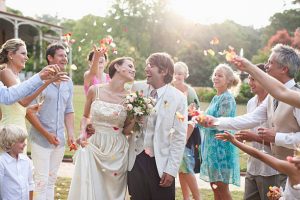Climate and location
The extent to which the location influences the way you approach photography will be contingent on the degree of difference from where you usually shoot.
Let’s look at the most typical scenario, that is when a photographer comes who lives in a climate that is temperate (Northern or Central Europe, North-East or North-West USA or Canada) traveling for a shoot at a sub-tropical or tropical area, like Hawaii as well as the Caribbean.
The first thing to discuss with your customer (after you’ve received the date for the wedding and venue) is the best time to hold the wedding.
I’ve shot weddings on the Caribbean beach without shade after 2 pm in July. And the heat is unbearable! 🙂
Apart from the heat, since the light is harsh and unflattering, nobody can keep their eyes open without squinting or wearing glasses, and the contrast is likely to be high. The typical flash on the camera isn’t up to filling for these conditions.
It is usually the case that the wedding guests need to be made aware ofof the possible issues or if they plan to marry at a resort with all-inclusive amenities where weddings are scheduled throughout the day.
If you can, convince the bride or groom to hold the wedding ceremony in the shade or (better than) to shift the ceremony time to one hour before sunset.
Weddings at sunset
Sometimes, you’ll hear the bride say, “I want to get married at sunset, just as the sun touches the horizon.”
This is generally a wrong decision. For one, as you are aware, every wedding begins with a minimum of 15 minutes delay. Also, in the tropical regions, the setting of the sun is at a more steep angle than it does further north or south, which means the twilight period is extremely short. If your wedding ceremony takes place in the evening, all photos after that will be shot in darkness so that the stunning location won’t be seen.
Therefore “sunset weddings” need to begin an hour beforebefore sunset to ensure that the best lighting happens right after the ceremony. This is precisely when you’re looking to snap photographs:
Not only will the lighting be better, but also the day will be cool so that everyone will feel more comfortable.
The light levels can change quickly during this time of the day, so pay attention to the shutter speed. Shooting manually usually is a good choice because the camera’s meter can be susceptible to being fooled by direct sunlight, the couple’s dark clothes, and sometimes reflections of light from the sand. I shoot in RAW, so you have some flexibility in post-production; however If you’re a JPEG shooter, you’ll have to be cautious.
Ideas for photos
It’s easy to get confused about what to shoot at an open beach with no typical props like doors, trees, or walls. You can create many things by using the light source, taking pictures from various angles, making silhouettes or side-lit images, and using fill flash to create a balanced sunset to make a great impression as well. If you do have the open shade you could use, like an umbrella, a beach hut, or a veranda, take advantage of it. You’ll see stunning light. However, your subject will be at ease.
A beach wedding that begins an hour before sunset can be more enjoyable for everyone, and the lighting is more pleasing. Photograph from various angles to benefit from the warm, soft lighting direction as sunset approaches. If the beach is white, it will be an excellent light to fill shadows.
If you face a bright sun, find an open area (such as the sides of a building or beneath the awning). Your subject will feel comfortable, and you’ll be able to enjoy soft and beautiful lighting that catches the eye. Even a beach that is empty will typically have backgrounds that you can make use of. I urged the couple to sit and relax in the grasses along the dunes.
If you own a flash, you can utilize it off-camera to illuminate your subject, still displaying the hues of the setting sun… …or go for a full-on look!
When the sun is set, stay. Even though tropical twilight isn’t long, it can provide stunning soft light perfect for intimate, gentle portraits (such as the photo above, with the couple on the dunes) I tend to shoot until there’s almost no light (or until my clients tell me they’re tired! )



